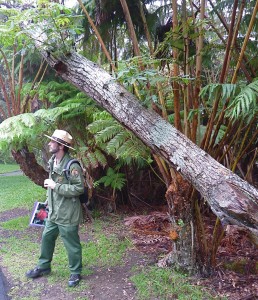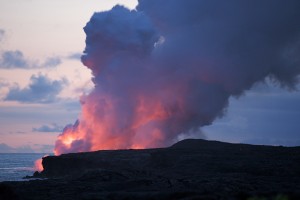Day 2: volcanoes and pigs
If it’s Tuesday the 26th again, this must be Hawaii.
After all the usual hassle of arriving in a new country, taking another flight, picking up a hire car, etc., I actually started sightseeing.
The first stop was the visitor’s centre at Hawai‘i Volcanoes National Park. (Quick aside: if you plan your trips right, the yearly pass that you bought in 2008 and used in a few National Parks can be reused nine months later for four more National Park visits.) Everything was clouded in, so there wasn’t much prospect of seeing any great views, let along taking photos with any kind of contrast.
A ranger, Ranger John, announced he was about to lead a tour to the Kilauea summit, so I took that. Although I already knew a bit about the volcanic origins of the islands, I certainly picked up much more (such as that the Big Island (Hawai‘i) was formed by five separate volcanoes, not counting the sixth which hasn’t broken the surface of the water yet). And, having trained in biology, the ranger presented a very enlightening introduction to the ecosystem on the islands, and in particular around Kilauea. For instance, did you know that wild pigs were causing a reduction in the number of certain flowers? They didn’t eat them; rather, the pigs ate the cores out of particular tree ferns, which created places for water to pool, which created breeding grounds for mosquitoes (since there aren’t any natural puddles or ponds, because water soaks right through the volcanic rock straight into bottles they sell at the airport for $3.30), which then spread various diseases among the birds that were adapted to feed on and cross-pollinate the flowers (in the absence of bees), and so the number of flowers fell. So they fenced off areas to keep the pigs out, and the flowers flourished again.
I also learned that the eruption from Halema‘uma‘u crater in early 2008 almost completely destroyed the crater overlook that I had visited three years ago. Its continuing activity would have been visibly impressive if it weren’t for the cloud we were standing in. (The cloud is hanging around because the northeast tradewinds have been delayed by La Niña.)
After checking into the very nice (and cheap) Volcano Inn, I set off for the end of Highway 130, where the road was blocked by lava in the 1980s. They’ve managed to build a single-lane road over the various lava flows, which takes you to a point from where you can hike over the lava to a viewing area. If you’re lucky, you can see the lava flowing into the sea about 800 metres away. Unfortunately, it was just out of sight today, so we had to make do with the steam (not vog, as one person watching said it was called) that was billowing generously, and then after sunset, the glow of the lava reflected from the clouds of steam. This in itself was pretty impressive, although I’m sure seeing the lava directly would top it.

